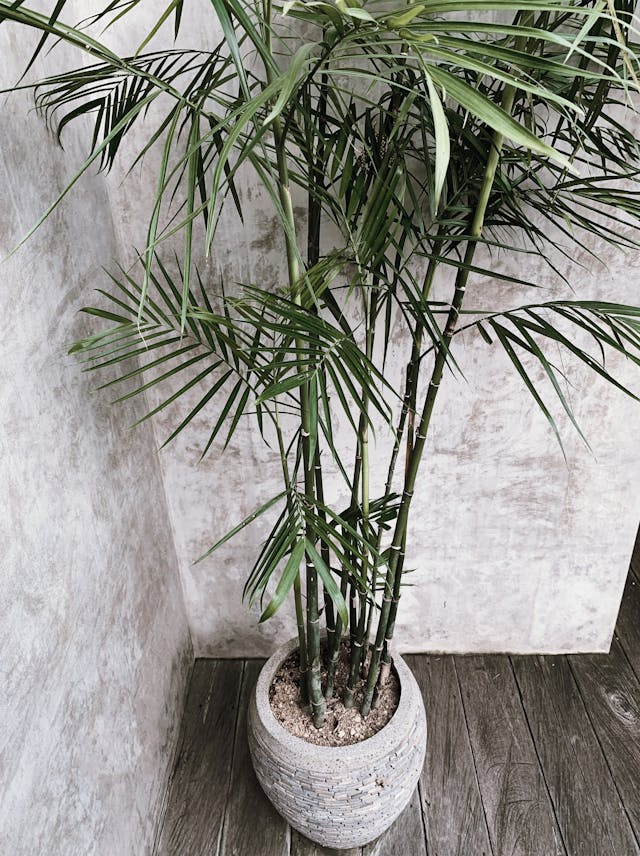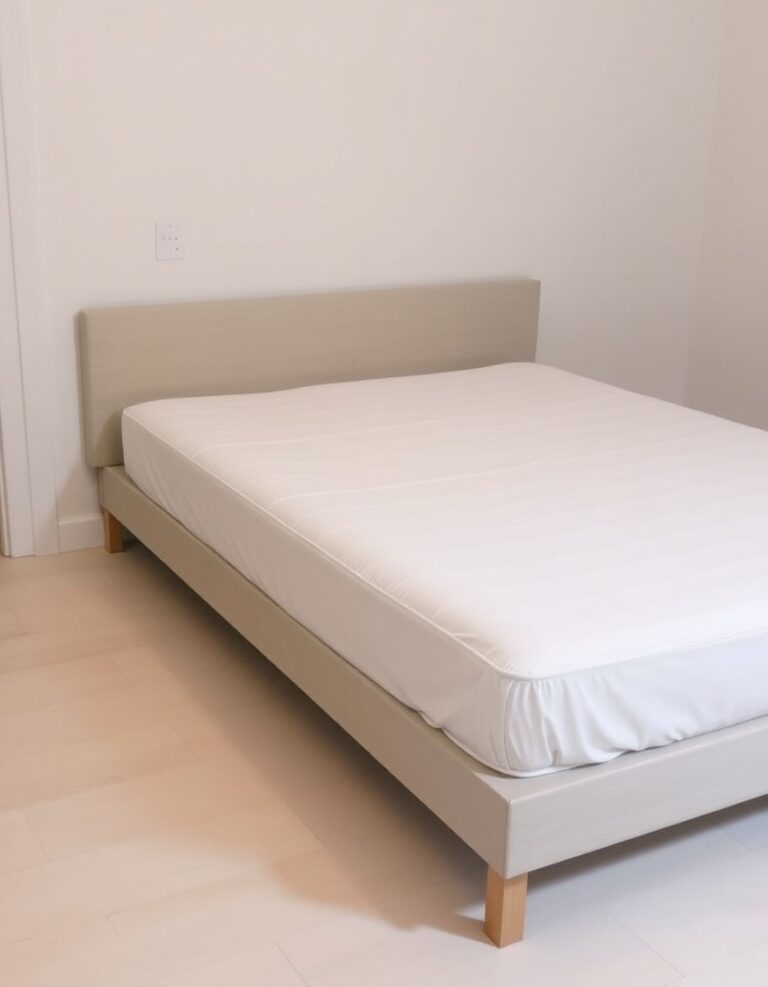In the realm of interior design, few combinations evoke the sense of serenity and sophisticated simplicity quite like the white and wood bedroom. This enduring duo brings together the clean crispness of white with the natural warmth of wood, creating spaces that feel both contemporary and comforting.
Whether you’re planning a complete white and wood bedroom overhaul or simply seeking to refresh your space, incorporating these elements offers a versatile foundation for minimalist design. This approach strips away excess while emphasizing quality, function, and thoughtful composition.
In this comprehensive guide, we’ll explore 20 distinctive white and wood bedroom ideas that will inspire your next minimalist makeover. From platform beds and floating shelves to statement walls and lighting solutions, these concepts will help you create a tranquil white and wood bedroom retreat that embodies minimalist principles without sacrificing style or comfort.
Why White and Wood Works for Minimalist Bedrooms
Before diving into specific design ideas, let’s understand what makes this combination so effective:
- Visual balance: The contrast between white’s brightness and wood’s warmth creates natural visual interest
- Versatility: This pairing complements virtually any architectural style
- Enduring appeal: Unlike trend-driven color schemes, white and wood remains relevant year after year
- Psychological benefits: The combination promotes relaxation and better sleep through its clean, uncluttered aesthetic
Now, let’s explore our curated collection of white and wood bedroom concepts.
1. Platform Bed with Floating Nightstands
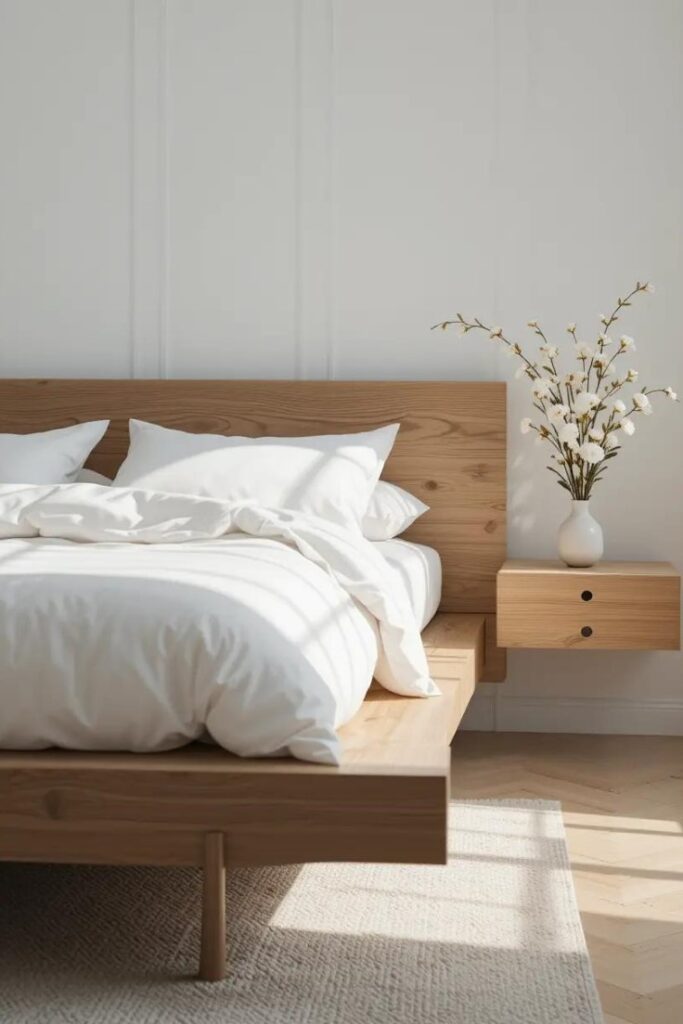
The cornerstone of minimalist bedroom design often begins with the bed itself. A low-profile wooden platform bed creates a strong horizontal line that grounds the space. When paired with matching floating nightstands, this arrangement maintains an open, airy feeling while providing essential functionality.
Design tip: Choose a bed frame in a medium-toned wood like oak or walnut to create sufficient contrast against white walls and bedding. The floating nightstands should maintain the same wood finish for cohesion.
2. Vertical Wood Slat Accent Wall
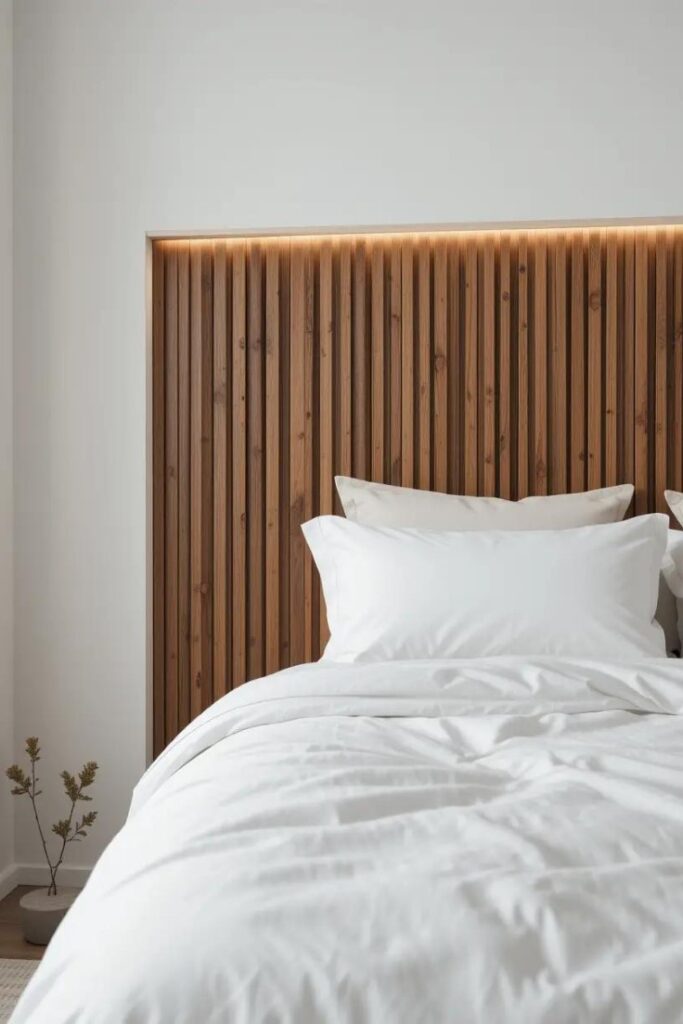
Adding a vertical wood slat wall behind your bed creates architectural interest without overwhelming the space. This technique brings texture and dimension while maintaining the minimalist color palette.
Design tip: Space wooden slats evenly and paint the wall behind them white to enhance the dimensional effect. Woods like pine or cedar work particularly well for this application.
3. Integrated Wood Headboard and Bedside Storage
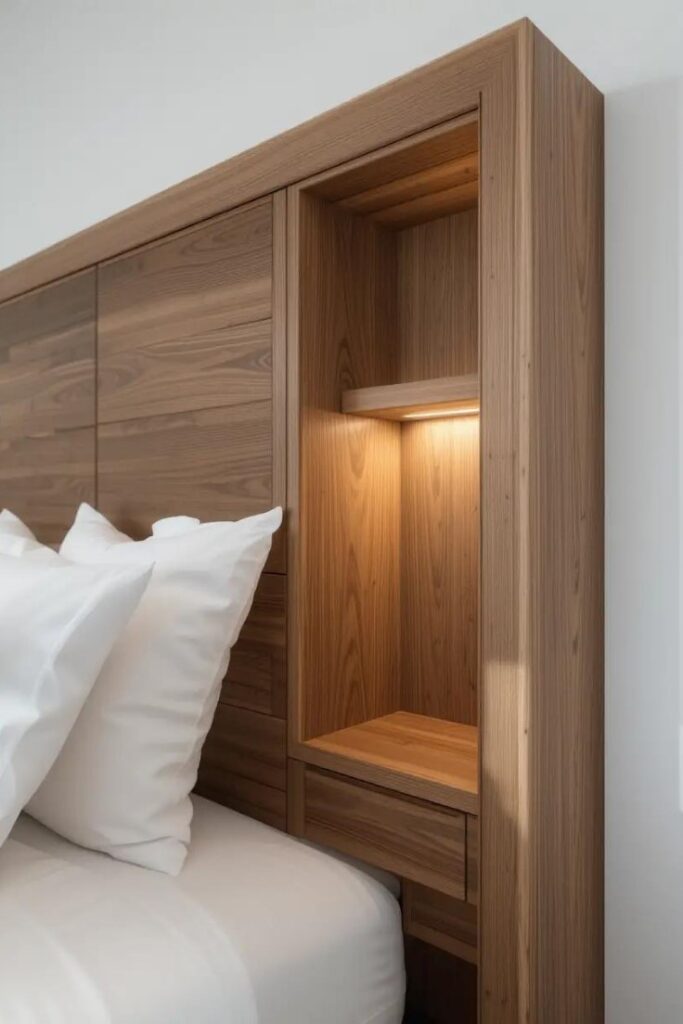
For the ultimate in functionality, consider a custom wooden headboard with built-in storage niches or shelving. This solution eliminates the need for additional furniture pieces while maintaining clean lines.
Design tip: Incorporate LED strip lighting underneath shelving areas for added functionality and ambient illumination.
4. White Built-ins with Wood Accents
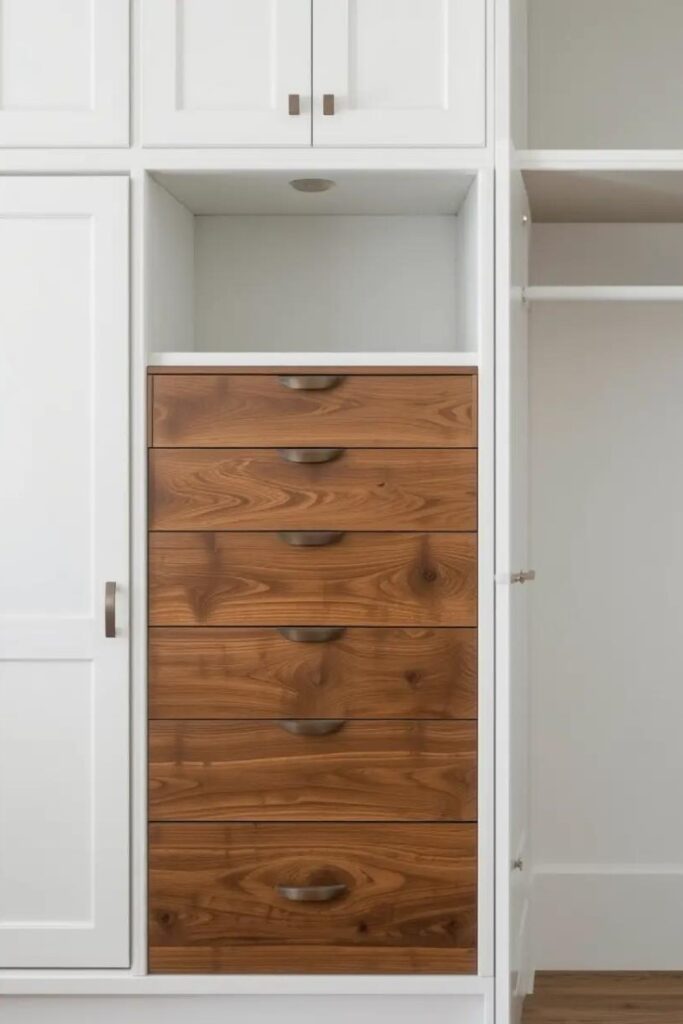
Custom built-ins maximize storage while maintaining visual simplicity. Design white cabinetry with wood handles, drawer fronts, or interior elements to maintain the color scheme while adding interest.
Design tip: Consider integrating a built-in window seat with storage drawers beneath—finished in warm wood tones—to create a cozy reading nook.
5. Exposed Wood Ceiling Beams
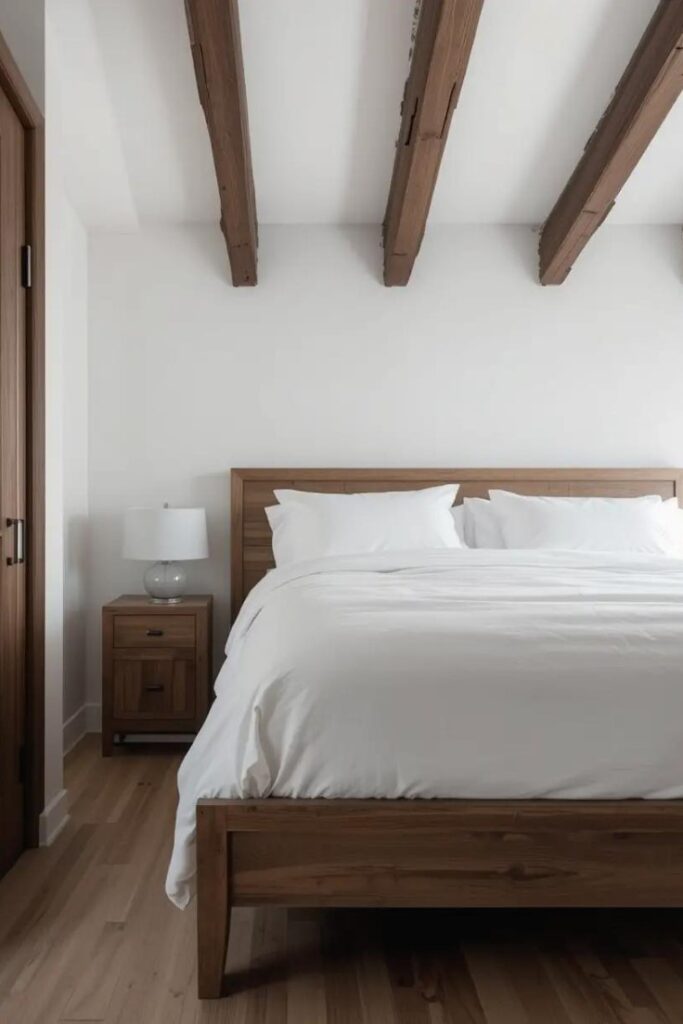
For architectural interest that draws the eye upward, exposed wooden beams against a white ceiling create stunning contrast. This approach works particularly well in spaces with higher ceilings.
Design tip: If structural beams aren’t an option, consider decorative box beams in a honey or walnut finish to achieve a similar effect.
6. Minimalist Wood Dresser with Clean Lines
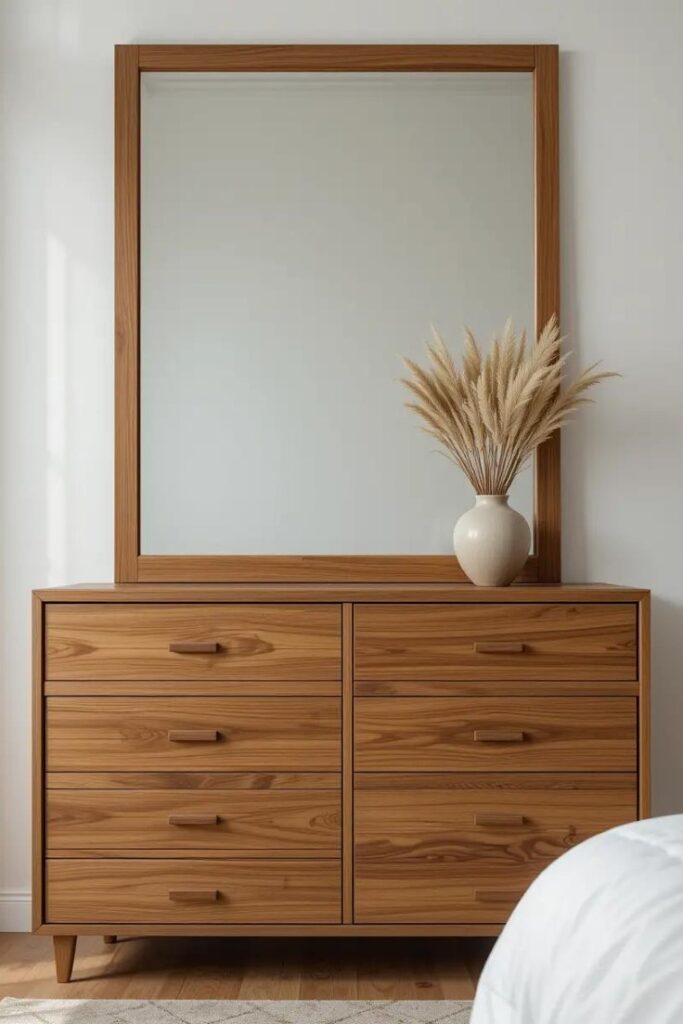
A well-designed wooden dresser with simple hardware (or none at all) provides necessary storage without visual clutter. Look for pieces with clean lines and minimal ornamentation.
Design tip: Position a large mirror above the dresser to amplify light and create the illusion of additional space. Choose a frame that matches or complements the wood tones elsewhere in the room.
7. White Textured Bedding with Wooden Bench
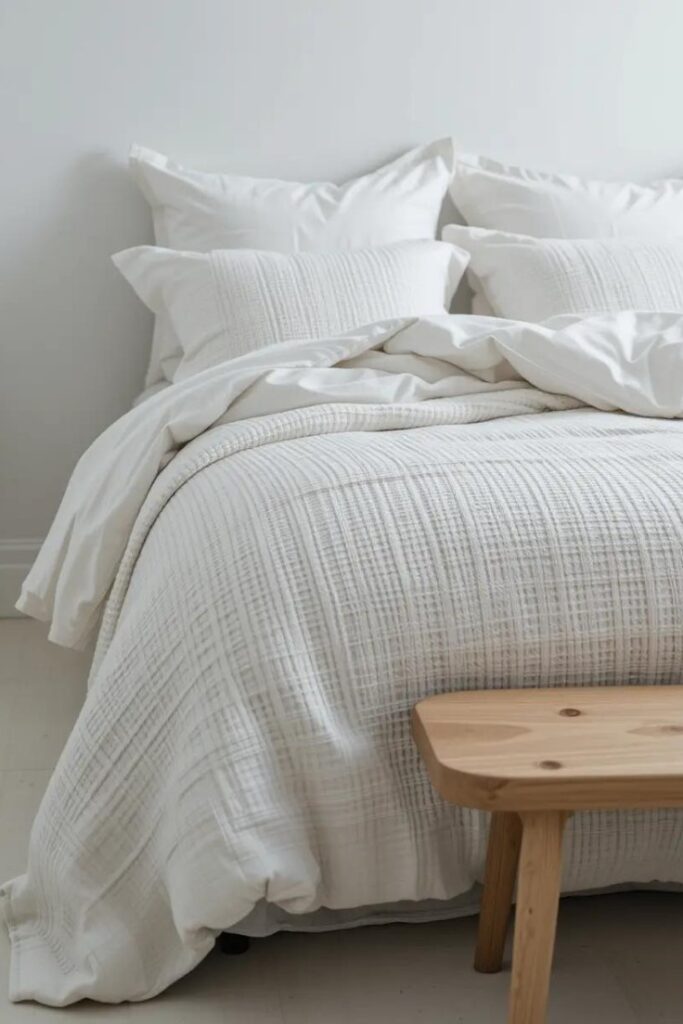
Create interest through textural variations rather than color. Layer white bedding with different textures (linen, cotton, knits) and anchor the foot of the bed with a simple wooden bench.
Design tip: Choose white bedding with subtle texture, such as waffle weave or matelassé patterns, to add dimension without departing from the monochromatic scheme.
8. Floating Wood Shelves Against White Walls
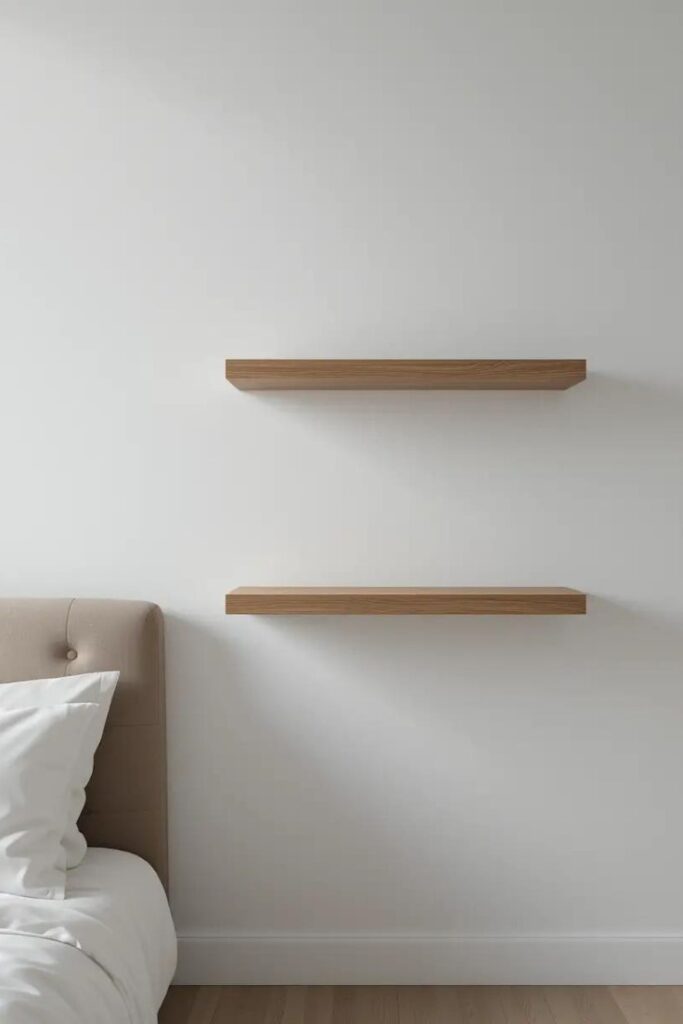
Floating shelves provide display space without the visual weight of traditional bookcases. Install wooden shelves against white walls for storage that complements the minimalist aesthetic.
Design tip: Limit shelf styling to a few select items—perhaps a small plant, a meaningful book, and one decorative object per shelf—to maintain visual breathing room.
9. Statement Pendant Lighting with Wood Elements
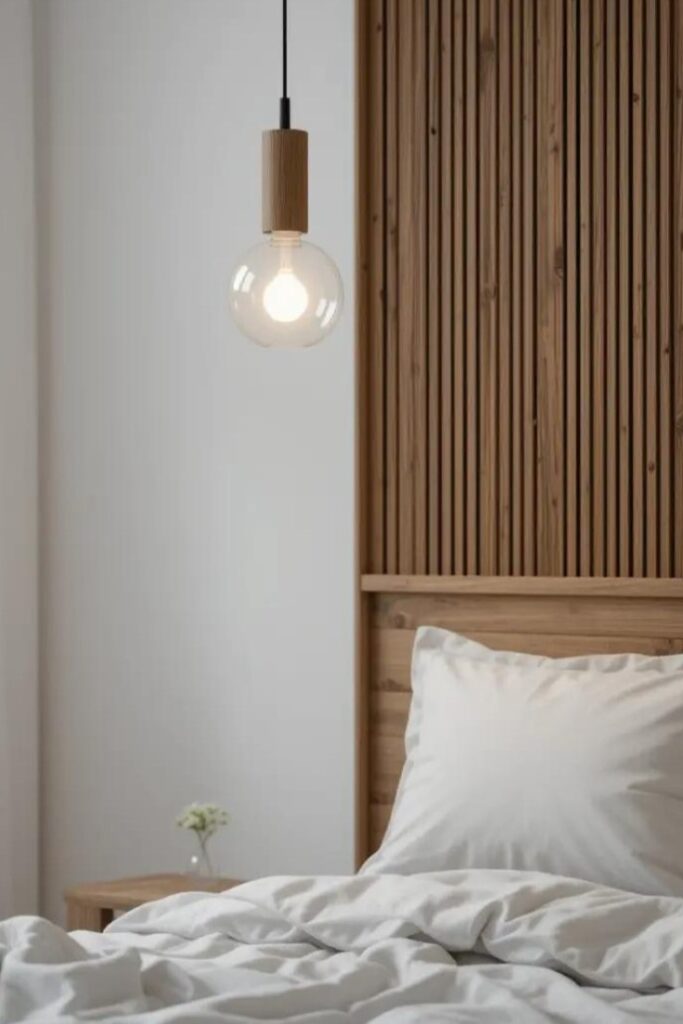
Lighting presents another opportunity to incorporate wooden elements. Choose pendant lights with wooden components to create a focal point that reinforces your design scheme.
Design tip: For bedside lighting, consider wooden wall sconces with adjustable arms to maximize functionality while enhancing your white and wood theme.
10. Wood-Framed Mirror with Minimalist Design
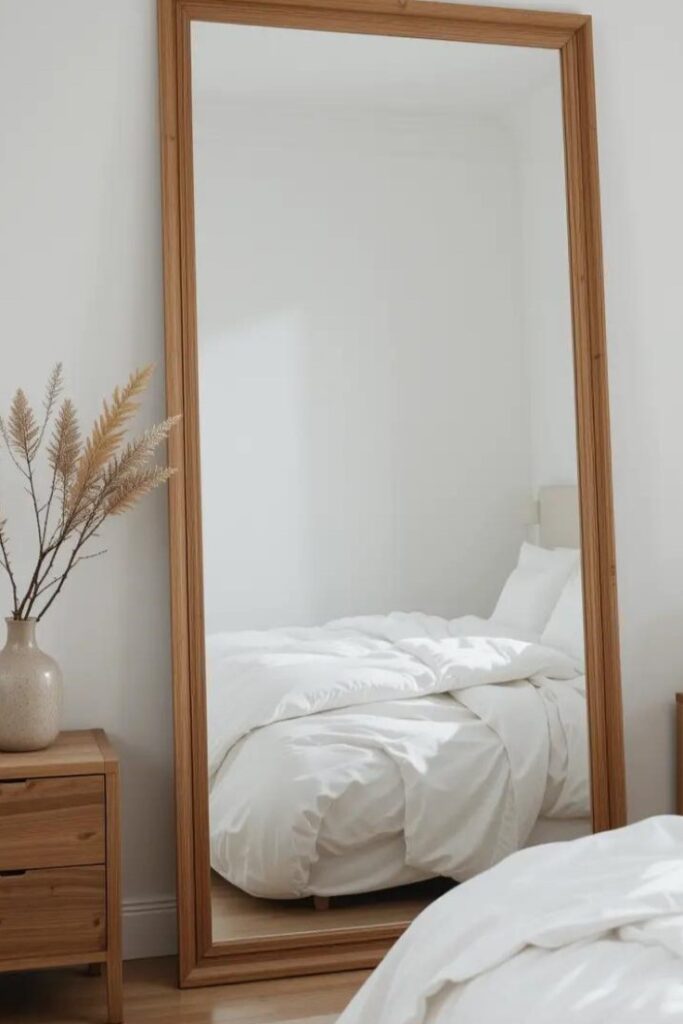
A large mirror with a wooden frame serves both practical and aesthetic purposes. Select a simple frame design that echoes the wood tones used throughout the space.
Design tip: Consider an oversized leaning mirror placed against the wall rather than hanging it to create a relaxed, contemporary feel.
11. White Walls with Wood Wainscoting
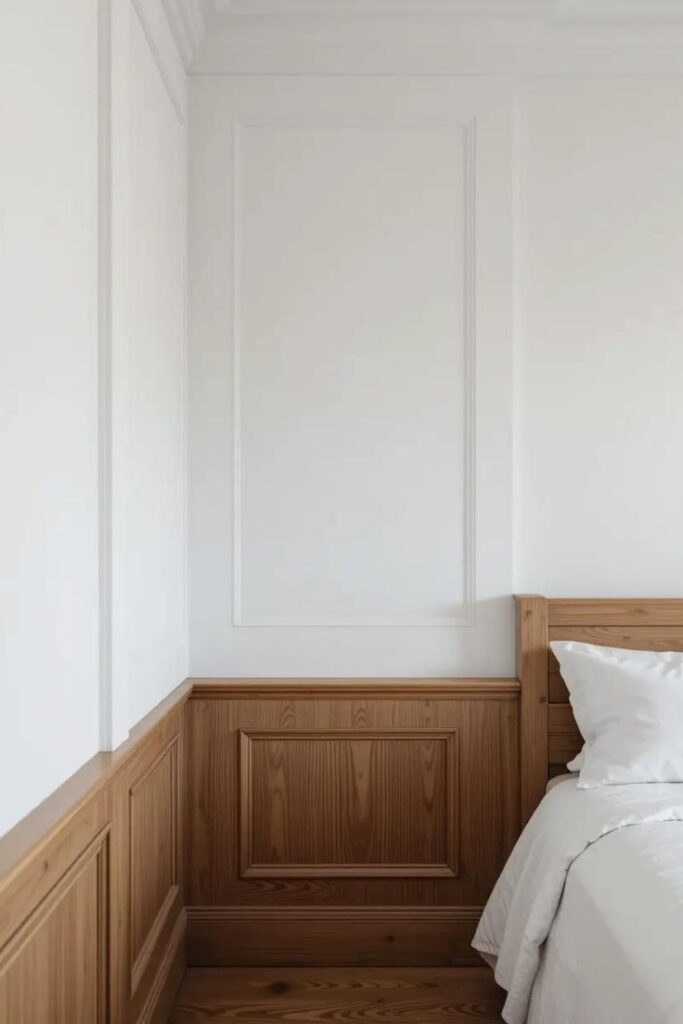
For architectural detail that doesn’t overwhelm your white and wood bedroom, install wooden wainscoting or paneling on the lower portion of walls, keeping the upper sections white.
Design tip: Extend the wainscoting to approximately one-third of the wall height, and use a semi-gloss white paint above to subtly distinguish the two sections while maintaining the minimal color palette.
12. Scandinavian-Inspired White and Birch Combination
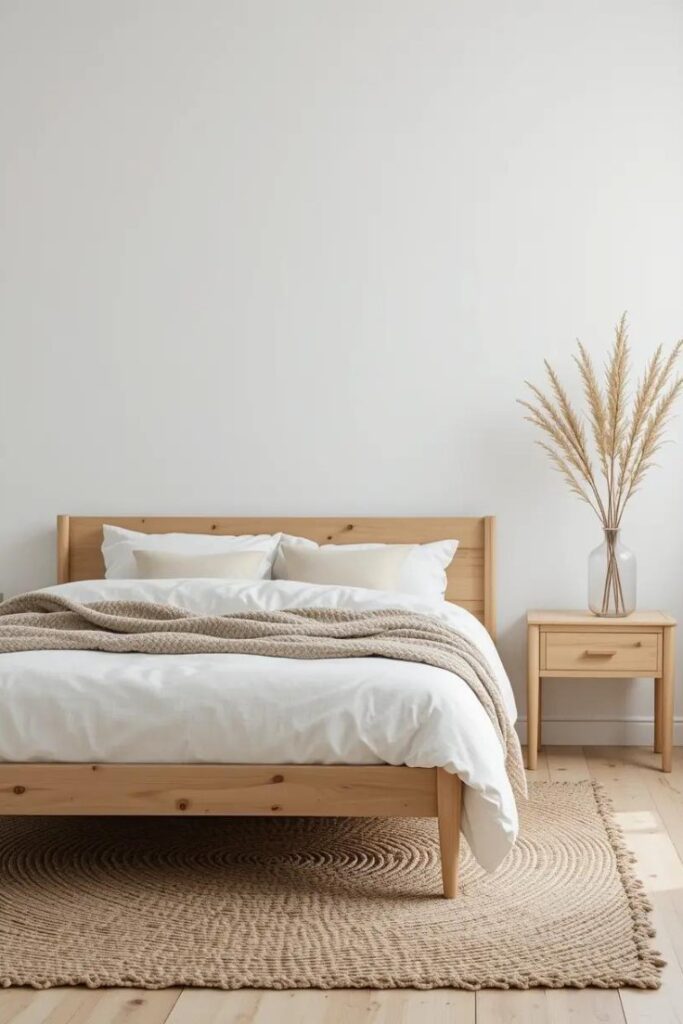
Embrace the Scandinavian design philosophy with lighter wood tones like birch or ash paired with crisp whites. This creates a particularly bright, airy feeling perfect for smaller white and wood bedroom spaces.
Design tip: Incorporate natural textures like wool, linen, and jute in neutral tones to enhance the Scandinavian aesthetic while maintaining the white and wood color scheme.
13. Wooden Window Frames and Treatments
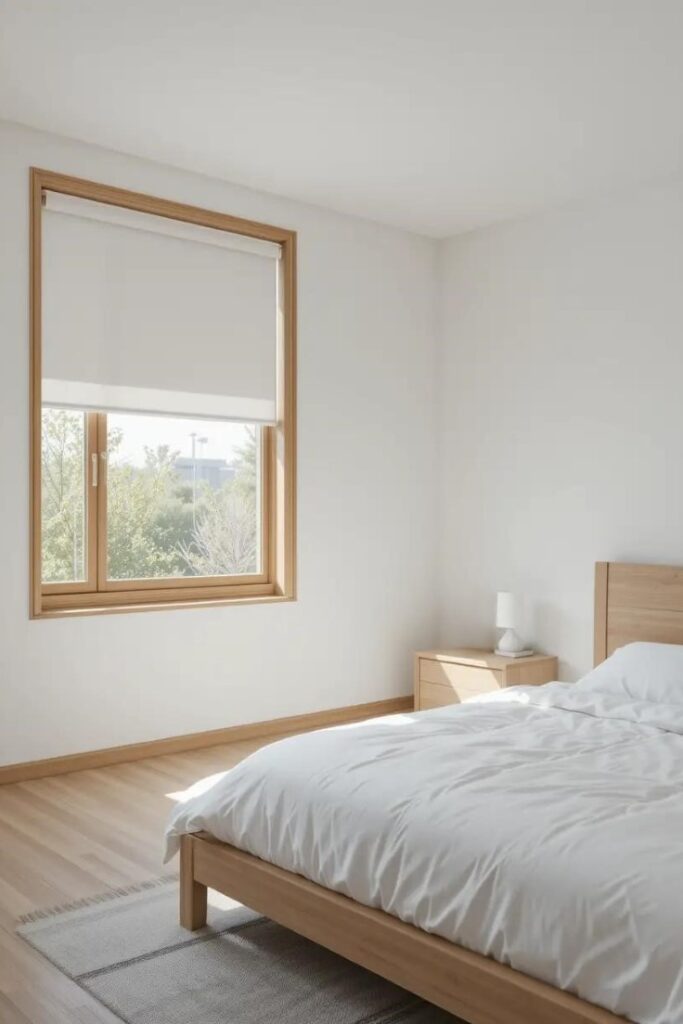
If replacing windows is within your budget, consider wooden window frames instead of vinyl or metal alternatives for your white and wood bedroom. Complement these with simple white roller blinds or wooden shutters.
Design tip: For an elevated look, choose window treatments that disappear into valances when open, maintaining clean lines when not in use.
14. White Bedding with Wooden Headboard Feature Wall
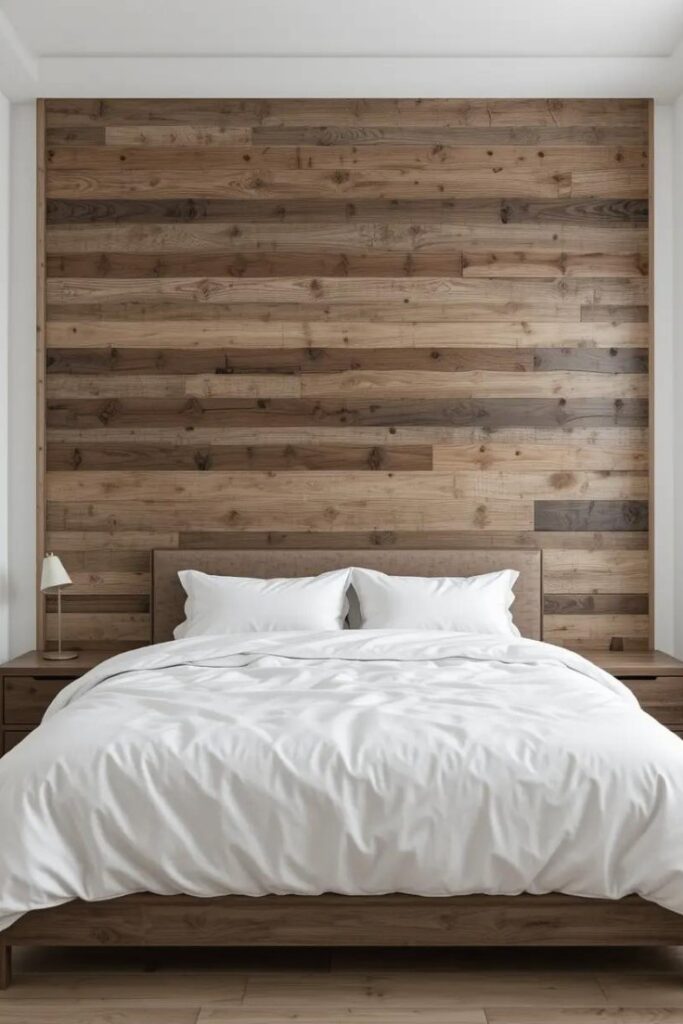
Create a striking focal point in your white and wood bedroom by extending your wooden headboard to cover the entire wall behind your bed. This dramatic touch anchors the room while white bedding and surrounding walls keep the space feeling open.
Design tip: Consider reclaimed wood for added character and sustainability. The natural variations in color and texture create subtle interest while remaining within your palette.
15. Minimal Wood Desk and White Chair Workspace
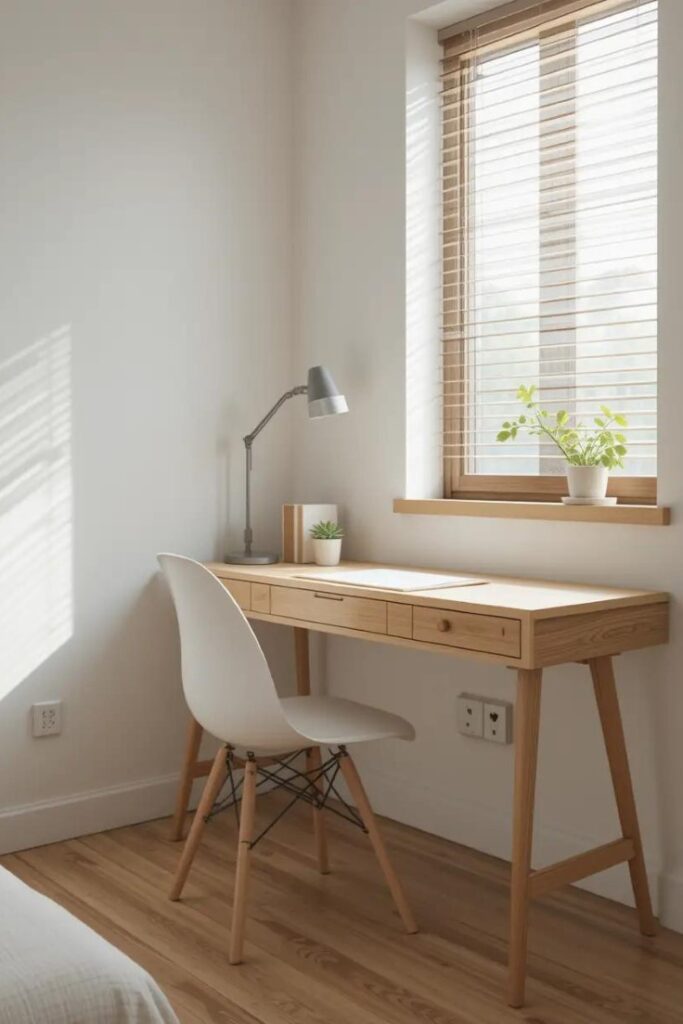
For white and wood bedrooms that must double as home offices, incorporate a simple wooden desk paired with a comfortable white chair. Position near a window when possible to maximize natural light.
Design tip: Choose a desk with minimal or hidden storage to maintain clean lines, and develop a system for keeping desktop essentials organized and out of sight when not in use.
16. White Closet Doors with Wood Hardware
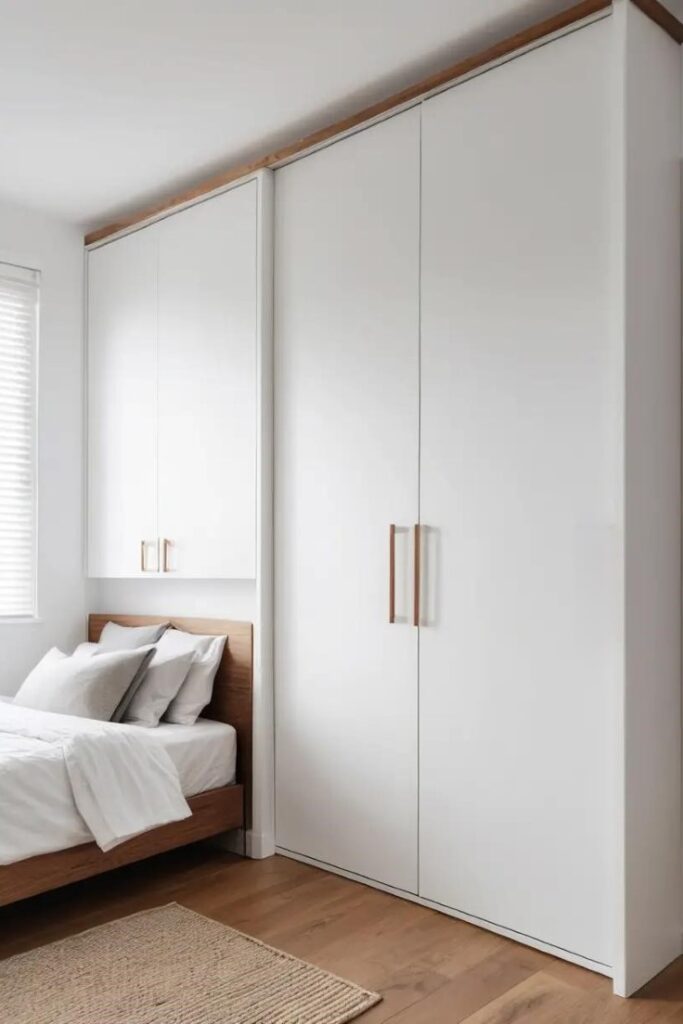
Replace standard closet doors with white panel doors featuring wooden handles or knobs. This small detail reinforces your white and wood bedroom design scheme while upgrading the overall finish quality of the room.
Design tip: Consider sliding barn-style doors in white with wooden rails and handles for a contemporary twist that saves space.
17. Wood Flooring with White Area Rug
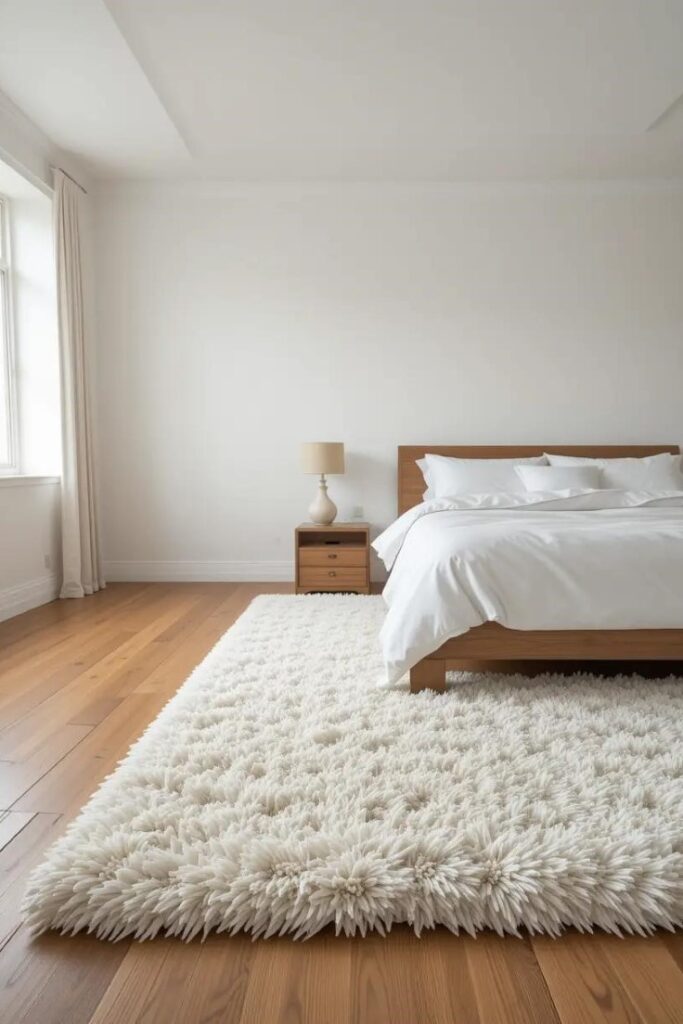
Wooden flooring provides a warm foundation for a white and wood bedroom. Layer with a plush white area rug to add comfort underfoot and define the bed area.
Design tip: Choose a high-pile or shag rug for textural contrast against the smooth wood flooring. Position it to extend beyond the bed on all three sides for a luxurious feel.
18. Minimalist Wooden Plant Stands with White Planters
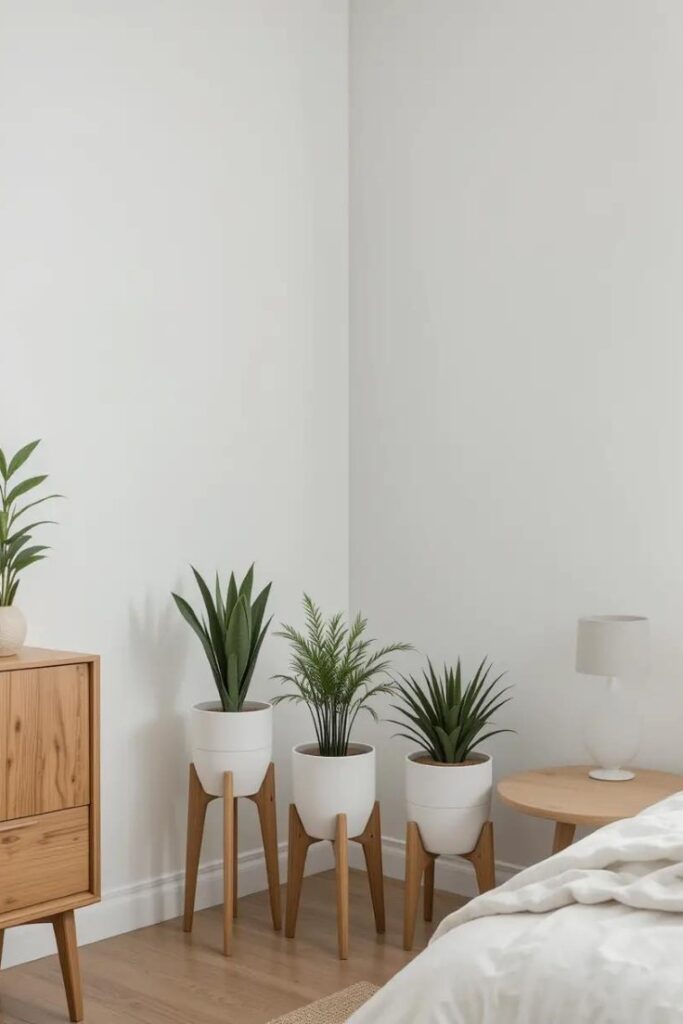
Introduce natural elements through plants displayed on wooden stands in your white and wood bedroom. Pair with white ceramic planters to maintain your color scheme.
Design tip: Select plants with architectural qualities, such as snake plants or rubber trees, whose forms complement minimalist design principles.
19. White Walls with Wood Picture Ledges
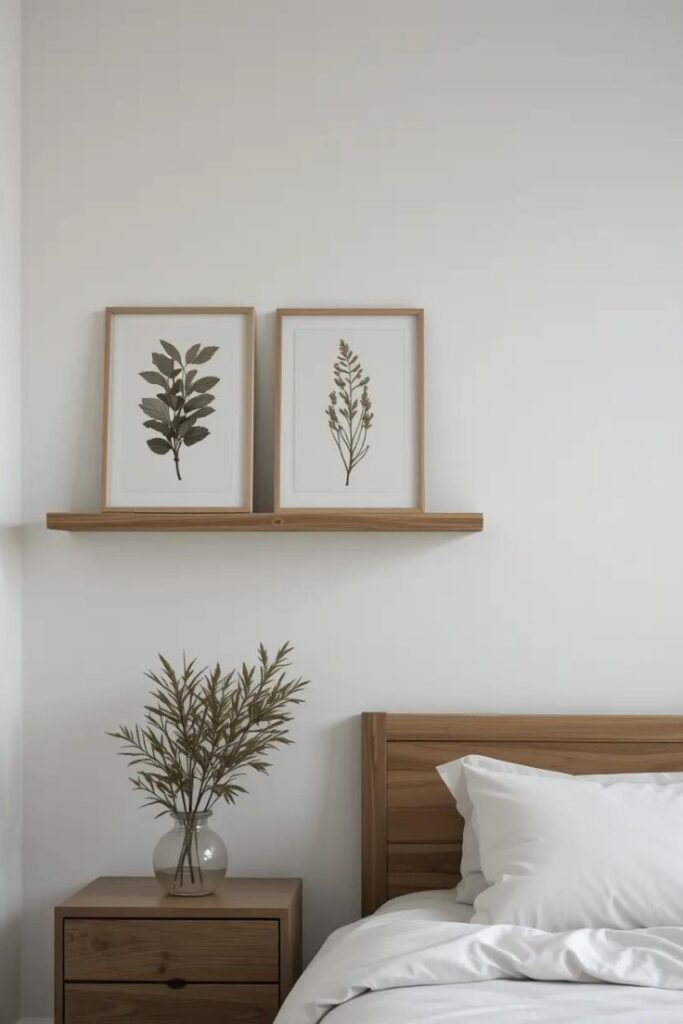
Instead of traditional framed wall displays, install wooden picture ledges to display decorative items and small objects in your white and wood bedroom. This approach allows for flexible styling and creates a curated feel.
Design tip: Keep the displays simple and intentional, with plenty of negative space. Group items with similar tones to maintain visual cohesion.
20. White Shiplap Walls with Natural Wood Ceiling
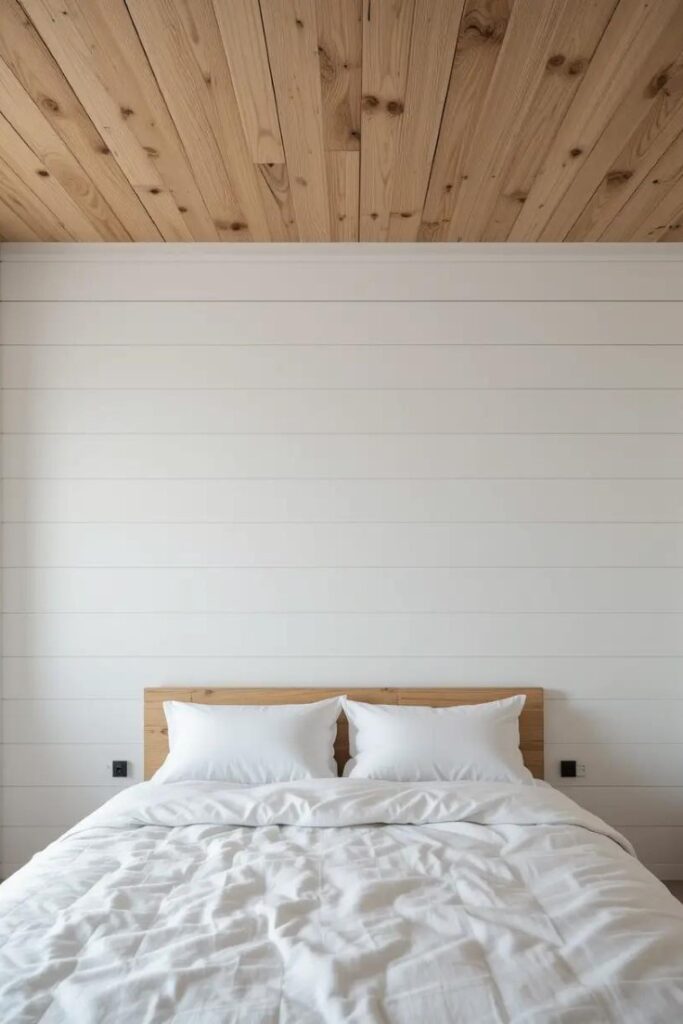
Create architectural contrast in your white and wood bedroom by combining textured white shiplap walls with a natural wood plank ceiling. This pairing offers visual interest through complementary materials while maintaining the minimalist color palette.
Design tip: Install horizontal white shiplap boards on walls and pair with exposed wooden ceiling planks in a medium tone like oak or pine. The contrasting linear patterns create a pleasing geometric interplay—horizontal lines on the walls guide the eye around the space, while the ceiling planks draw attention upward. Ensure adequate lighting that highlights the textural differences between the smooth ceiling wood grain and the subtle shadows of the shiplap seams in your white and wood bedroom.
Creating Your White and Wood Bedroom: Implementation Tips
As you plan your minimalist white and wood bedroom transformation, keep these key principles in mind:
Quality Over Quantity
Invest in fewer, better pieces rather than filling the space with many lesser-quality items. In minimalist design, each element should serve a purpose and deserve its place in the white and wood bedroom.
Maintain Consistent Wood Tones
While woods don’t need to match exactly, they should complement each other in your white and wood bedroom. Choose either all warm-toned woods (like cherry, walnut) or cool-toned woods (like ash, maple) for cohesion.
Incorporate Texture
Minimize visual interest through varied textures rather than colors or patterns. Consider linen bedding, wool throws, ceramic accessories, and natural fiber rugs—all in white or neutral tones that complement your white and wood bedroom design.
Prioritize Function
Every item should earn its place through purpose and utility. Before adding any element to your white and wood bedroom, ask whether it serves a function beyond mere decoration.
Create Visual Breathing Room
Resist the urge to fill every surface or wall. Negative space is essential in minimalist white and wood bedroom design, allowing the eye to rest and the carefully chosen elements to shine.
Consider Scale and Proportion
Choose furniture that suits the dimensions of your space. Oversized pieces can overwhelm smaller white and wood bedrooms, while undersized elements can look insubstantial in larger spaces.
Conclusion
A white and wood bedroom offers the perfect foundation for minimalist living, combining visual simplicity with natural warmth. By implementing these 20 ideas, you can transform your bedroom into a tranquil retreat that exemplifies the best of minimalist design principles.
Remember that the essence of minimalism lies not just in aesthetics but in intentionality—choosing quality over quantity, function over excess, and thoughtful composition over random accumulation. Your new white and wood bedroom will not only look beautiful but support a more mindful, peaceful lifestyle.
Frequently Asked Questions
What type of wood works best with white for a minimalist bedroom?
Almost any wood can work well in a white and wood bedroom, but your choice should depend on the atmosphere you’re trying to create. For warmer, cozier spaces, choose woods with red or yellow undertones like cherry, oak, or walnut. For brighter, more contemporary spaces, opt for lighter woods like maple, ash, or birch. The key factor is consistency—select a primary wood tone and carry it throughout your design for cohesion.
How can I prevent an all-white and wood bedroom from feeling cold or stark?
The secret to preventing a stark feeling in your white and wood bedroom lies in texture and layering. Incorporate various textural elements like knitted throws, woven baskets, linen bedding, and natural fiber rugs. These add warmth and dimension without introducing additional colors. Also, ensure your lighting includes warm-temperature bulbs (2700-3000K) rather than cool white, as lighting dramatically affects how warm a space feels.
Is it better to choose white walls with wood furniture or wood walls with white furniture?
This depends on your white and wood bedroom space and preferences. White walls with wood furniture is generally more versatile and easier to change over time. This approach also makes rooms feel larger and brighter. Wood walls (or a wood accent wall) with white furniture creates a more defined, cocooning effect that can feel especially cozy in bedrooms. Consider your room’s natural light—rooms with less light often benefit from more white surfaces to maximize brightness.
How do I maintain the clean look of white bedding and furniture?
Regular maintenance is essential for a white and wood bedroom. Choose washable, bleachable fabrics for bedding and consider performance fabrics for upholstered furniture. Develop habits like removing makeup before touching pillows, keeping food and colored beverages away from white furniture, and addressing spills immediately. For wooden elements, use appropriate wood cleaners and polish periodically to maintain their finish and prevent drying or cracking.
What’s the ideal ratio of white to wood in a minimalist bedroom?
While there’s no strict formula for a white and wood bedroom, a general guideline is the 60-30-10 rule: approximately 60% of the room in your dominant color (typically white for walls, ceiling, and larger furniture pieces), 30% in your secondary element (wood for furniture, flooring, or accent features), and 10% in accent elements (could be black hardware, plants, or subtle textural variations). This creates visual balance while maintaining the minimalist aesthetic.
How can I add personality to a white and wood bedroom without compromising the minimalist style?
Focus on quality over quantity when adding personal touches to your white and wood bedroom. Choose one or two meaningful decorative pieces, a special textile, or a statement light fixture that reflects your personality. Plants also add life and character while enhancing the natural quality that wood brings to the space. The key is being highly selective—each item should have significance and purpose rather than filling space for the sake of decoration.
Is it possible to incorporate white and wood in small bedrooms?
Absolutely! In fact, this combination works exceptionally well in smaller spaces. White visually expands rooms, while wood adds necessary warmth and character. For compact white and wood bedrooms, focus on light to medium wood tones rather than darker varieties, which can feel heavy in limited space. Consider multi-functional furniture like platform beds with storage, wall-mounted nightstands, and floating shelves to maximize floor space while maintaining the aesthetic.


